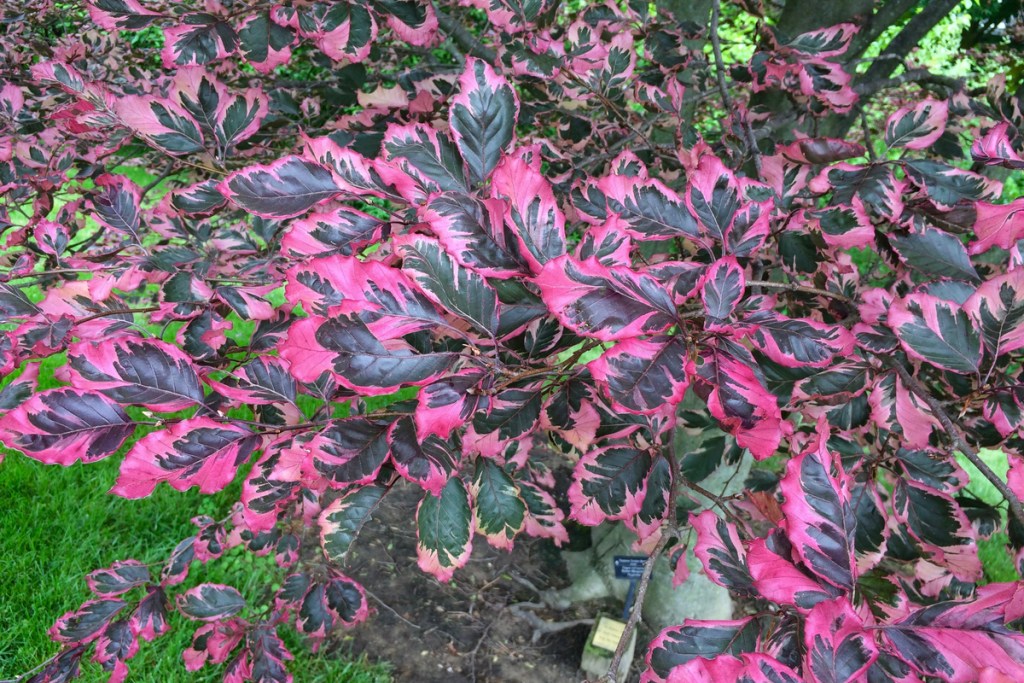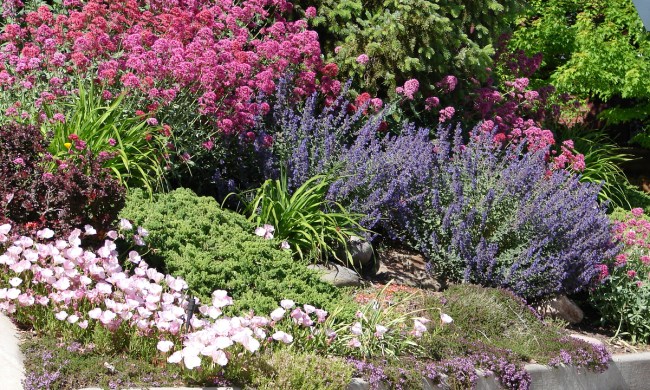
When you think about a garden, is pink the first color that comes to mind? Pink is a beautiful flower color for roses, tulips, or any number of annual flowers, and it makes a wonderful accent on emerging foliage. Sometimes pink mature foliage, like the big leaves on some caladiums, add a nice splash of color not unlike the effect of blooming azaleas.
From low-growing pink perennials to towering pink trees, we’ve got a little something for everyone on this list. If you’re looking for pink plants for landscaping or just brightening up a corner of your home, why not try out one of these fantastic pink plants?
Pink trees

Tricolor beech, Fagus sylvatica “Tricolor”
Mature size: 30 feet tall, 20 feet wide
Hardiness zones: 4 to 7
Tricolor beech is a strikingly variegated tree that makes an excellent accent or specimen tree for smaller city lots. The deep purple leaves have irregular rose and creamy pink margins that give an overall impression of pink. The smooth, gray bark offers year-round interest and a youthful appearance well beyond maturity. This cold-hardy tree works just as well as an accent among evergreens or as a shade tree along the street or a driveway.
Flamingo boxelder, Acer negundo “Flamingo”
Mature size: 35 feet tall and wide
Hardiness zones: 5 to 8
Flamingo boxelder offers beautiful cream and green variegated foliage with strong pink overtones through spring that can persist throughout the year in cool growing zones and a deep golden fall color. The coarse texture and variable shape make this tree an outstanding choice to accent a monochromatic building, mixed shrub border, or woods edge. It also grows well in difficult, low-lying areas with wet soil.
Pink Japanese maple, Acer palmatum “Oridono Nishiki”
Mature size: 18 feet tall, 12 feet wide
Hardiness zones: 5 to 9
Growing as much as 2.5 feet per year, Pink Japanese maple is one of the fastest-growing variegated Japanese maples. This old cultivar displays constant color change throughout the growing season, from tri-colored pink, cream, and green when it emerges in the spring, to deep pink, green, and white in summer, then a brilliant pinkish red in early fall before deepening to maroon just prior to leaf drop. With minimal pruning, the green bark changes to candy-striped pink in winter for year-round interest.
Pink shrubs

Dappled willow, Salix integra “Hakuro-nishiki”
Mature size: 15 feet tall and wide
Hardiness zones: 4 to 9
The tri-colored dappled willow shows off its spectacular pink, white, and green foliage on bright pink stems each spring. The lance-shaped leaves mature to light green and white by midsummer. The gracefully weeping branches, with their striking pink stems and buds, offer outstanding winter interest. It grows well as an understory shrub beneath shade trees and tolerates wet areas, making it an excellent choice as an accent for water features or rain gardens.
Rainbow dog hobble, Leucothoe fontanesiana “Rainbow”
Mature size: 3 to 5 feet tall and wide
Hardiness zones: 5 to 9
Rainbow dog hobble puts on a show each spring with its arched branches and colorfully marbled cream and pink foliage taking on a deeper cast while the new growth emerges. Clusters of showy white flowers grace the plant in late spring, before the leaf color fades to summer gold. Use this shade-loving plant to break up the redundancy of green hedges in foundation plantings or as a natural woodland accent plant.
Confetti abelia, Abelia x “Conti”
Mature size: 3 feet tall and wide
Hardiness zones: 5 to 9
Confetti abelia adds a subtle splash of color that changes through the seasons. In spring, new variegated green and white leaves emerge with a rosy hue. During summer, they mature to a crisp green and white, with tiny reddish flower buds that open to reveal pinkish-white, sweetly fragrant flowers in late summer and fall. As cool weather approaches, the foliage again changes, taking on a bronze-pink cast. This is an excellent choice for full sun or partial shade, whether in mass plantings or in containers.
My Monet weigela, Weigela florida “Verweig”
Mature size: 1.5 feet tall, 2 feet wide
Hardiness zones: 4 to 6
This dwarf weigela features a compact growth habit and showy foliage that makes it versatile in the garden. The variegation changes based on sun exposure, with crisp white and green variegation in lower light, taking on a deeper hue in full sun. The pink trumpet-shaped flowers burst each spring, with scattered repeat flowering throughout the growing season. This plant works well in drift plantings to edge landscape beds, as container plantings, or anywhere you need a splash of color.
Pink vines

Snow N Summer Asiatic jasmine, Trachelospermum jasminoides “Snow-N-Summer”
Mature size: 1.5 feet tall, 4 feet wide
Hardiness zones: 7 to 9
This woody-stemmed trailing evergreen features glossy leaves that emerge deep pink before turning solid white, then maturing to emerald green with white variegation. Small, creamy yellow, fragrant flowers cover the plant in midsummer. Snow N Summer jasmine makes a striking ground cover when planted en masse, as a woodland garden edge planting, or as a trailing accent in a mixed container.
Arctic beauty kiwi vine, Actinidia kolomikta “Arctic Beauty”
Mature size: Trailing to 20 feet
Hardiness zones: 3 to 8
One of the most cold-hardy kiwi vines, Arctic Beauty is a vigorous male cultivar with variegated heart-shaped foliage in shades of pink and white. It will not set fruit, but does set small, fragrant white flowers in early summer. For fruit production, a female Actinidia kolomikta cultivar would also be needed, but their variegation is not as dependable. Arctic Beauty quickly covers trellises, arbors, or fences, and is particularly useful for screening and walls.
Pink perennials

Garden phlox, Phlox panniculata
Garden phlox is a stunning perennial that will bring pink to your garden year after year. From the vibrant pink of varieties such as “Pink Flame” and “Glamour Girl” to the pale pink of “Bubblegum Pink” garden phlox comes in a stunning array of shades to choose from. Plant your garden phlox in full sun to partial shade and water them regularly, and before you know it, you’ll have a garden full of this lovely spreading perennial.
Maiden pink, Dianthus deltoides
The dianthus genus as a whole has the common name pinks, and while they aren’t named after the color, they do bloom in many shades of pink! Their common name actually comes from pinking shears, which leave a distinct fringed edge similar to the petals of dianthus. Not all species of dianthus are perennials, but maiden pinks are. These beautiful low-growing pinks are perfect for containers, garden borders, or creating carpets of small pink flowers. Plant them in full sun, well-draining soil, and water them when the soil is dry for the best results!



